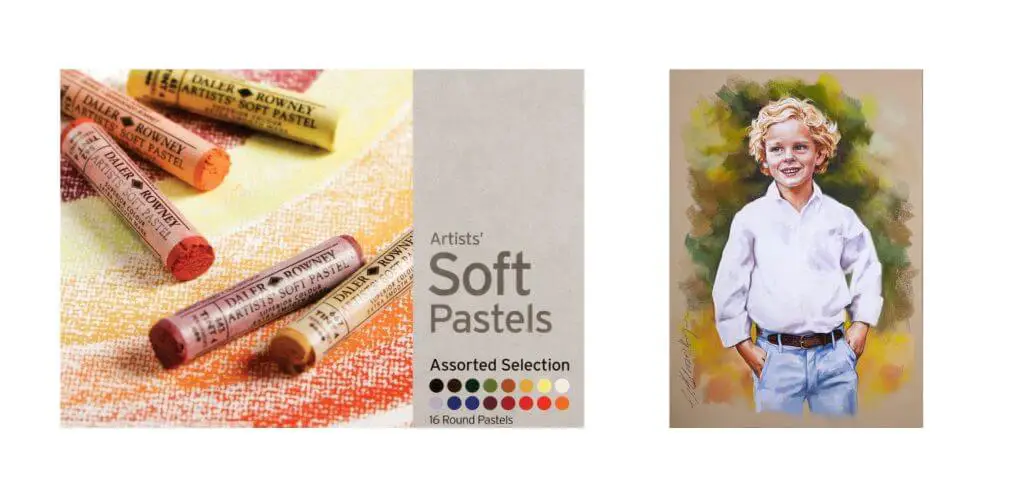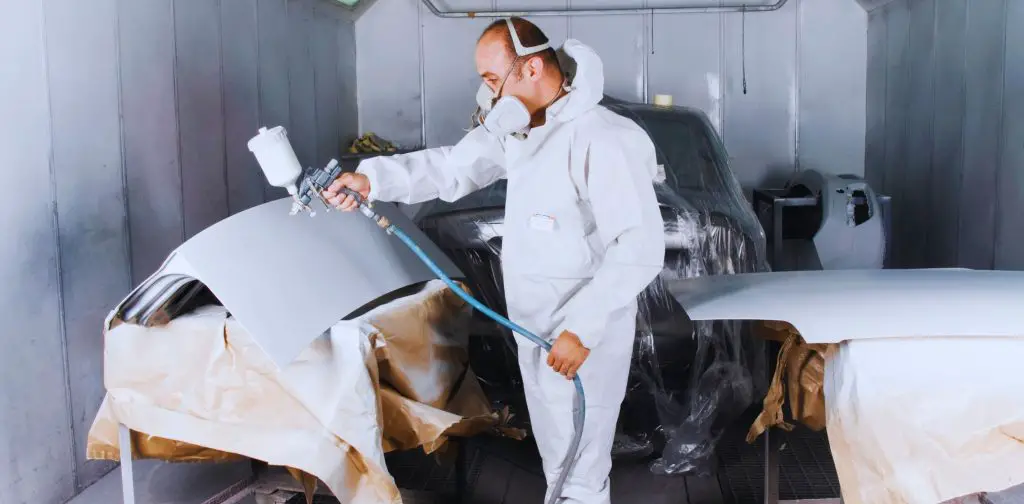Are your windows feeling a bit dull lately? If you’re on the lookout for a creative way to boost your privacy or bring an artistic flair to your living area, consider the captivating world of painting glass windows. This artistic approach not only revitalizes your windows but also serves as a canvas for expressing your creativity.
In this comprehensive guide, we’ll delve into the art of painting glass windows, exploring the techniques, tools, and tips you need to embark on this exciting journey.
Table of Contents
Why Paint Glass Windows?
Glass windows offer an elegant and often underutilized canvas for creative expression. Whether you’re seeking to infuse your space with personality, enhance privacy, or simply explore your artistic talents, painting glass windows can accomplish all this and more.
Personalization: Express yourself by translating your unique style onto your windows. Painted glass windows are like pieces of art, reflecting your personality and adding a personalized touch to your living space.
Privacy Enhancement: Striking the balance between privacy and natural light can be challenging. With painted glass windows, you can obscure the view from outside while allowing ample light to filter through.
Cost-Effective Décor: Painting your windows is an affordable way to revamp your living space. It requires minimal investment in supplies and can yield stunning results, creating a stained glass effect.
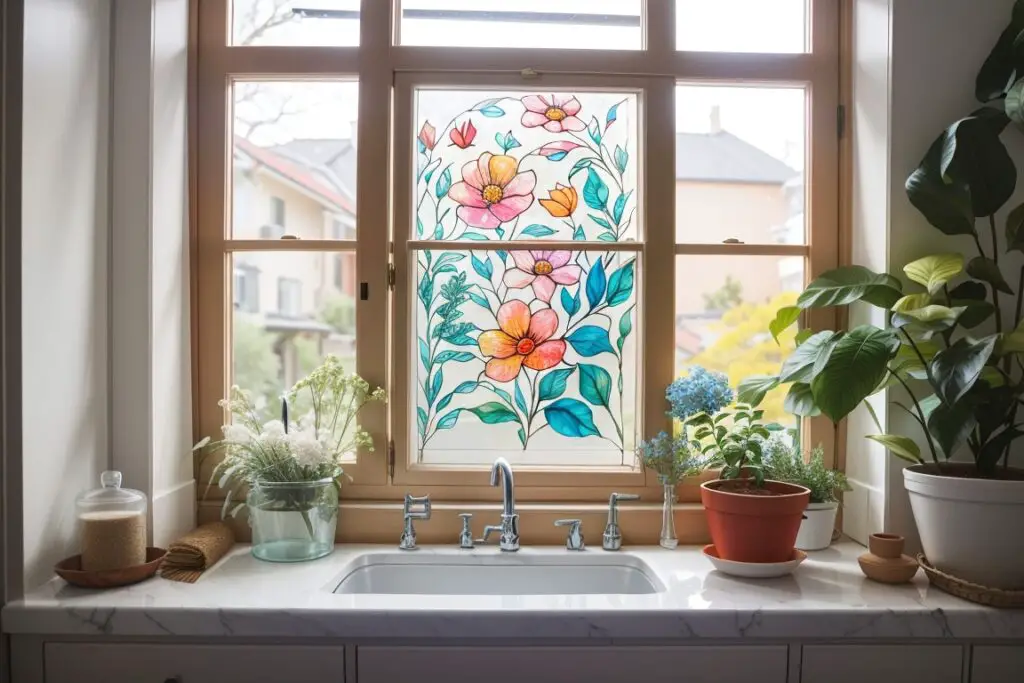
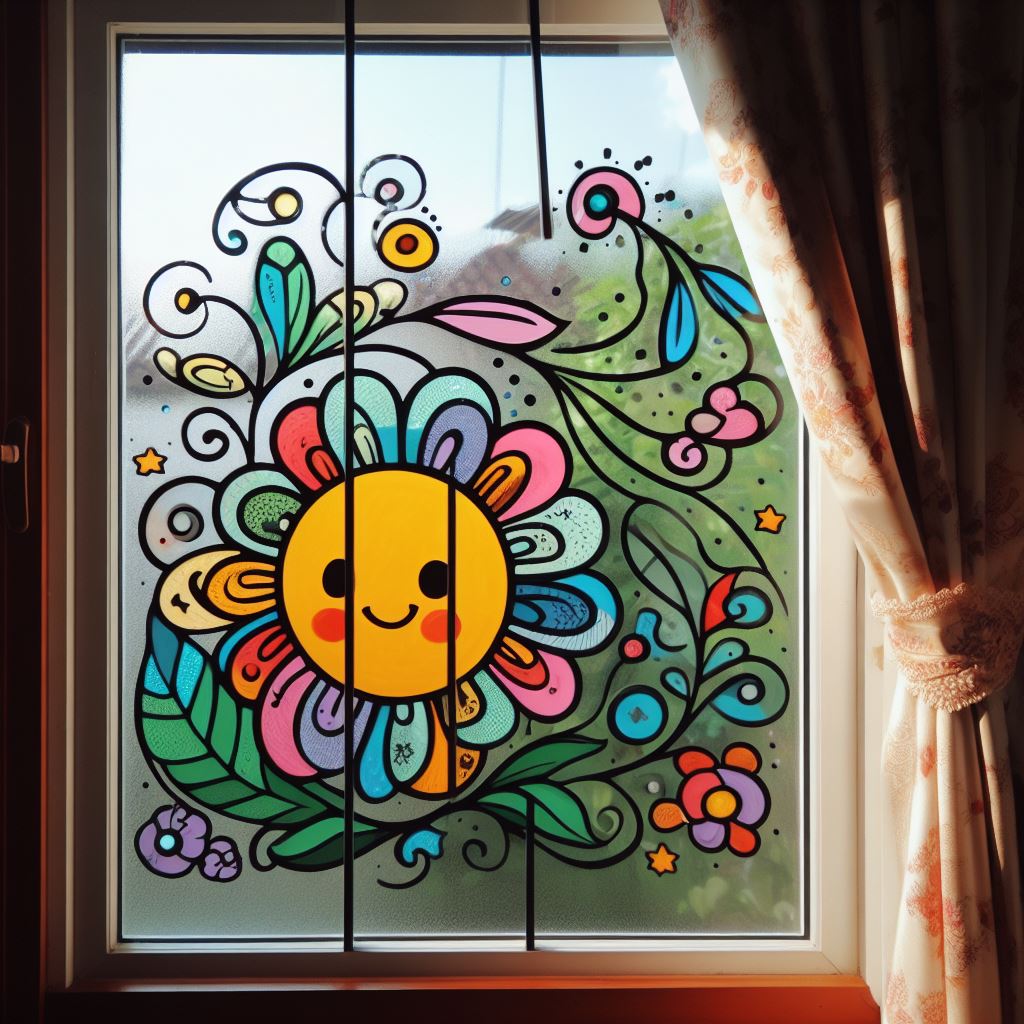
Choosing the Right Paint for Glass Windows
The choice of paint significantly influences how your project turns out. When venturing into glass painting, the first step is to familiarize yourself with the various types of paint. Selecting the right paint for glass is crucial for achieving a satisfactory outcome and ensuring its longevity. Different glass paints offer diverse finishes and effects, so it’s essential to align your choice with your envisioned final project.
Given that glass is non-porous, it’s imperative to use paint specifically formulated for glass painting to ensure the durability of your creation. While everyday oil-based paint is excellent for porous surfaces, it’s unsuitable for glass. On the other hand, water-based latex paint, due to its difficulty in application and tendency to peel off when dry, is not the ideal choice.
Here are some popular paint options to consider:
Acrylic Enamel Paint: This versatile paint is a top choice for glass window painting. It adheres well to glass, dries quickly providing a high sheen finish. Whether you desire a solid color for privacy or a translucent look, acrylic enamel paint delivers. You can modify the opacity by adjusting the number of coats applied.
The acrylic enamel paint can be transparent or opaque. Also, it offers glossy and frosted window glass colors. This type of acrylic is also more durable and permanent, in addition, it is best suited for smooth surfaces like glass. In the majority of cases, this type of paint must be cured in the oven after it dries. However, in certain brands this is optional, and the paint can simply be air-dried. This is why always read the label to see if the paint can be used on the surface you are painting.
FolkArt acrylic enamel paints are an excellent choice for those new to glass painting. These paints are non-toxic, making them safe for beginners. They are user-friendly and specially formulated for glass surfaces. With the FolkArt Gloss Finish Acrylic Enamel Craft Set, you’ll have access to a versatile palette of 16 vibrant colors to kickstart your glass painting journey.
FolkArt is a popular name in the painting industry for making professional colors for creative crafts. It is an American brand. So, the quality you get will be top-notch.
If you’re ready to elevate your glass painting game, consider exploring premium acrylic enamel paints like Pebeo Vitrea. This non-toxic, water-based paint is a favorite among professionals. It offers a diverse palette of stunning colors and a range of finishes, including glossy, shimmering, and frosted options. Discover the possibilities with Pebeo Vitrea.
Frosted Glass Paint: If you’re aiming for visual obstruction without sacrificing light, frosted glass paint is the answer. It offers translucency while blurring visibility, making it an excellent choice for bathrooms or street-facing windows.
Acrylic Paint with Gesso: For a matte finish that covers existing colors or designs, acrylic paint with gesso is ideal. Using a roller pad can simplify the application process. This type of paint is similar to acrylic enamel in its durability and has the ability to cover up existing colors or designs on your window which makes it ideal for covering up old painted windows.
Tempera – Temporary Glass Paint: When you want a temporary design that can be cleaned off at the end of the day or are working on painted windows, tempera paint, a water-based option, is the best to use. Made from egg or casein, it’s safe for glass surfaces. It consists of colored pigments mixed with a water-soluble binder producing translucent colors that can be made more intense with multiple layers. The paint comes in various colors, dries quickly, and can be easily removed from painted windows.
Washable window paint can give you the freedom to experiment with different designs before committing to a longer-lasting paint, which is great when you are trying out different window art ideas.
Other Factors to Consider
Important to note is that if you are not working with clear glass, the paint may be affected by the window glass colors. The texture of your glass can also impact the final look of your project so be sure to test your window painting ideas and colors on a separate sheet of glass or in a section of the window that is not as visible before painting the whole window.
Choosing the Right Brushes
To achieve the best results when painting glass, selecting the right brushes is crucial. Synthetic bristle brushes are your best bet, as they are less likely to leave marks on the glass. For larger areas, consider using a roller pad or a sponge instead of a paintbrush. Remember not to overload the brush with paint, as this can cause it to stick to the glass.
Paint Brushes: Synthetic brushes are our recommendation because these tend to be the least stick against surfaces, which means they are less likely to leave marks on your window, making painting easier.
Whether you’re just starting or looking to elevate your glass painting game, there’s a brush suitable for you.
BOSOBO Paint Brushes are an excellent choice for beginners and casual painters. They provide reliable performance without breaking the bank.
ARTIFY Paint Brushes, on the other hand, offer superior craftsmanship and materials, making them the preferred choice for professional artists and those seeking impeccable results for intricate glass painting projects.
Paint Roller: A roller can be helpful if you’re taking on a large-scale project and need to cover an expansive area evenly.
Applicator Sponges: Sponges work well if you’re using a stencil, as they’ll help achieve an even, flawless application of color. Apply the paint in thin coats with a sponge; they can soak up more paint than you expected. You can also use sponges to create a textured finish.
What Materials Are Required to Paint Glass Windows?
Once you have decided on what paint is right for you and your project, you can begin creating your glass window art. Before you start to paint glass windows, it is necessary to collect together all the relevant materials. This includes the paint, a cleaning solution to clean both your window before working and clean the brushes while working, and most importantly the correct paint. This is what you will need:
- Paint of your choice, prepared accordingly
- Paintbrushes with synthetic bristles or sponges
- Painter’s tape or masking tape
- A bucket of water for brush cleaning
- An old towel or sheet
- Protective gloves
- Paper and pencil
- Scissors
- Liquid leading or a dry erase marker
- Soft cloth
- Rubbing alcohol
- A pallet for mixing colors
- Cups for each color (if using tempera powdered paints)
- Window cleaner and a clean cloth for post-painting cleanup
The Art of Painting Glass Windows
Now that you have your supplies ready, let’s dive into the art of painting . We have created the following easy step-by-step guide to ensure you get the best results when creating your very own temporary or permanent window art designs. Let’s walk through the steps:
Step 1: Prepare Your Workspace
Before starting, ensure your workspace and your window is clean and dry. Cover any surfaces you want to protect from paint splatters, protect the sills with newspapers or rags. Sandwich your window between two pieces of newspaper or cloth while painting to prevent paint drips.
Use soap and warm water to clean all of the dirt off your windows. You wouldn’t want to be painting on top of dirt! Take some rubbing alcohol to get all of the grease and smudges off the glass surface. Once it is all clean allow it to air dry before you start painting.
Step 2: Choose Your Design
Decide on your design. You can draw freehand or use stencils for precise patterns. Tape off anywhere you don’t want to paint over. This will make your painting a lot more precise and reduce mistakes. Use painter’s tape to mask off areas you don’t want to paint, like the window frame. You can check out painter’s tape or alternatively, you can use masking tape.
Step 3: Outline Your Design
Using a fine-point Sharpie pen, pencil crayons or oil pastels to outline your design on the glass. This technique ensures your paint won’t cover your artwork. Draw out the design that you wish to paint so that all of the boundaries are set. If you aren’t comfortable drawing directly on the window, draw on some tracing paper the same size as your window so that you have a template.
Step 4: Paint Away
Fill in your design using your chosen paint. Dip your synthetic bristle brush lightly into the paint, ensuring all bristles are covered. Avoid overloading the brush. Apply the first coat of paint with the brush. Or if you prefer you could use a sponge to apply the paint for larger areas or a roller for smooth application. Pick an application method that goes best with your design.
Optionally, while not essential for acrylic enamel paint, you may need to apply a coat of gesso or white acrylic if you’re using tempera or aiming for an opaque finish.
Step 5: Allow to Dry
Patience is key. Let your masterpiece dry thoroughly before assessing whether you need a second coat. Check to see if the colour is vibrant enough for you and that the design you are after is looking perfect. If not, then go in with a second coat.
Drying times may vary. For example, tempera paint dries in minutes, while water-based paints usually take about an hour. Enamel may require 8-24 hours to dry, depending on how thick the coat is.
Step 6: Seal the Deal
For long-lasting results, apply clear varnish in multiple layers over your painted glass windows. This step ensures the paint remains vibrant and durable.
Step 7: Clean Your Brushes:
Wash your brushes thoroughly in soapy water until they are clean.
Achieving Transparent and Opaque Effects
Depending on your preference, you can make your window glass look transparent or opaque.
Transparent Look: For a transparent effect, use waterproof acrylic enamel paint. The opacity can be adjusted by varying the number of coats.
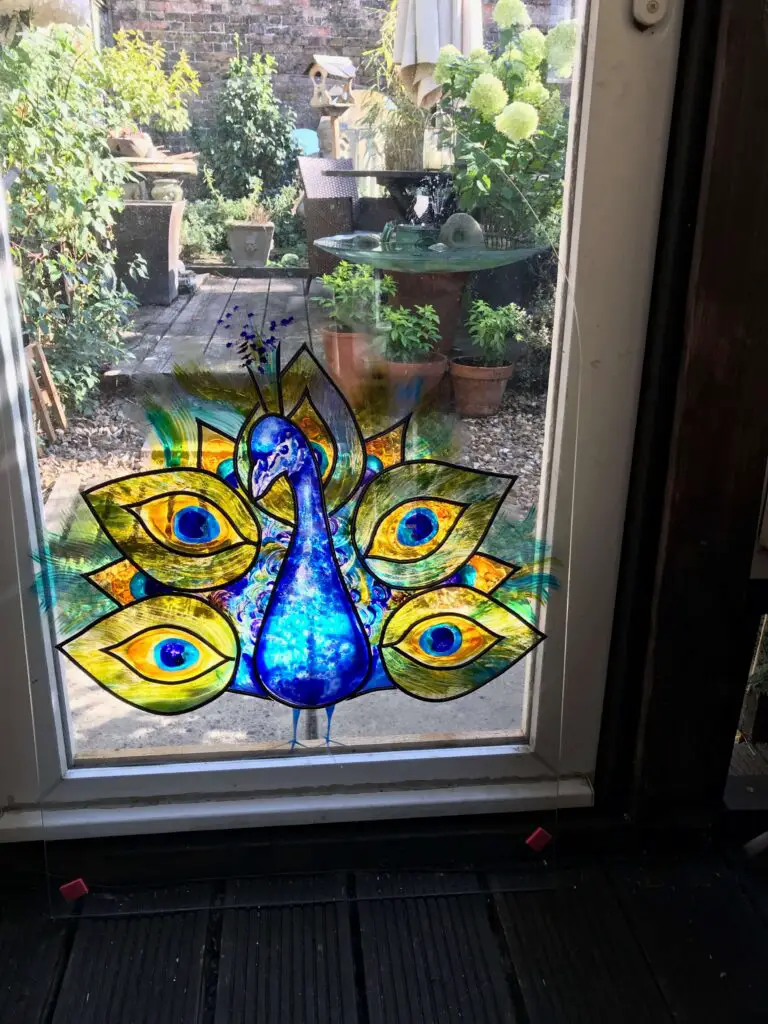
Opaque Look: To create an opaque appearance, add white paint to your chosen color. You can also apply a layer or two of gesso before you start adding your base coat. Thanks to its matte texture, gesso creates an excellent surface on which you can paint later. When applying gesso, do it with an even coat using a natural brush. Make sure you give the base coat enough time to dry. It should be at least an hour! It will prevent the paint from bleeding. Also, consider that drying times often vary, so make sure you double-check the directions on the paint can before you start using it.
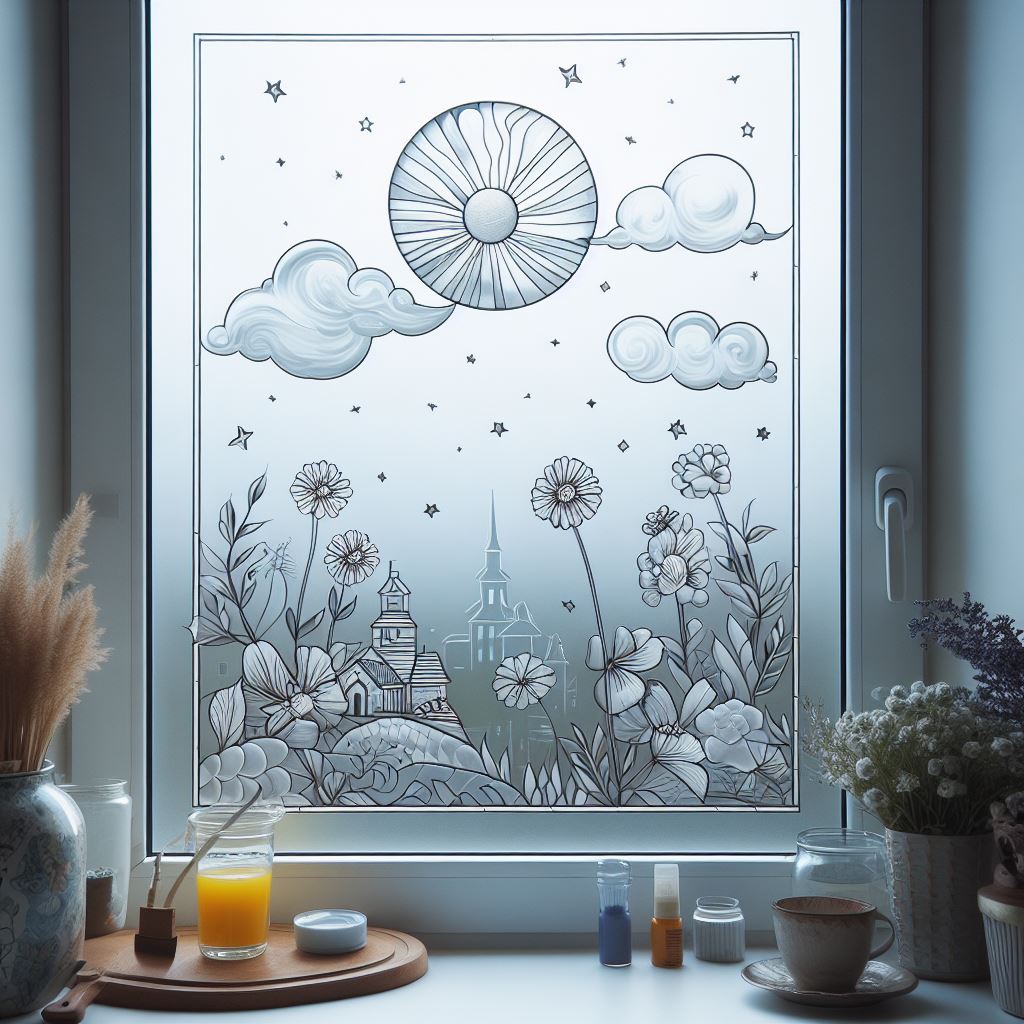
Additional Painting Tips
- If possible, paint your windows in an airy room to avoid exposure to fumes.
- Ensure your glass window is clean and dry before painting to prevent color from running.
- Dark colors are ideal for windows without curtains, as they are less likely to show dirt.
- Avoid using oil-based paints for glass windows, as they are challenging to clean and may fade quickly.
- If you are not working with clear glass, the paint may be affected by the window glass colors. The texture of your glass can also impact the final look of your project so be sure to test your window painting ideas and colors on a separate sheet of glass or in a section of the window that is not as visible before painting the whole window.
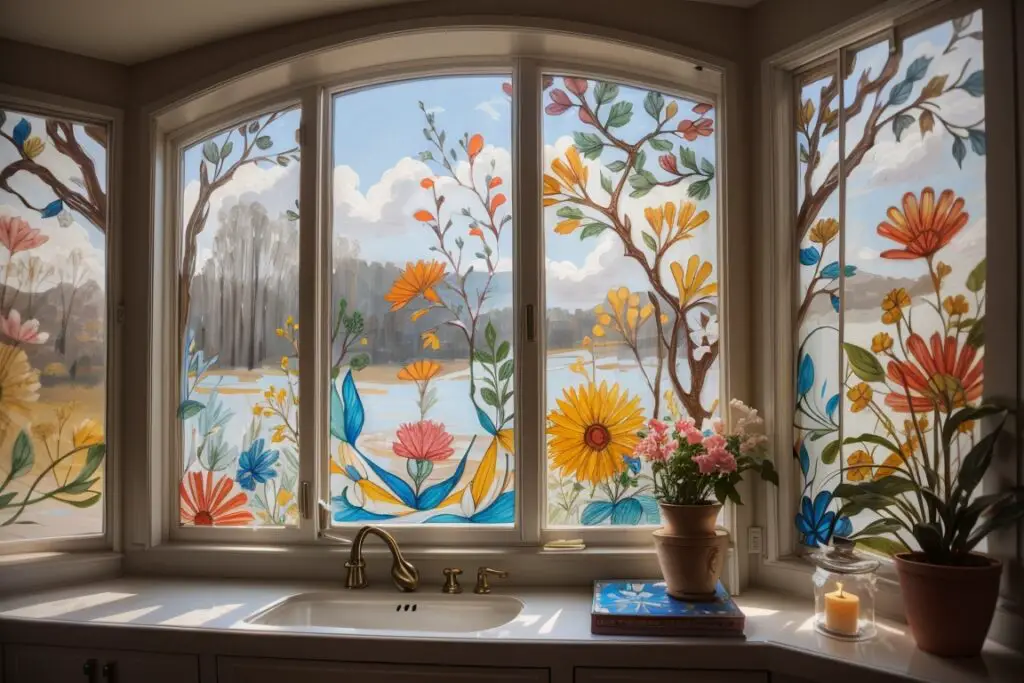
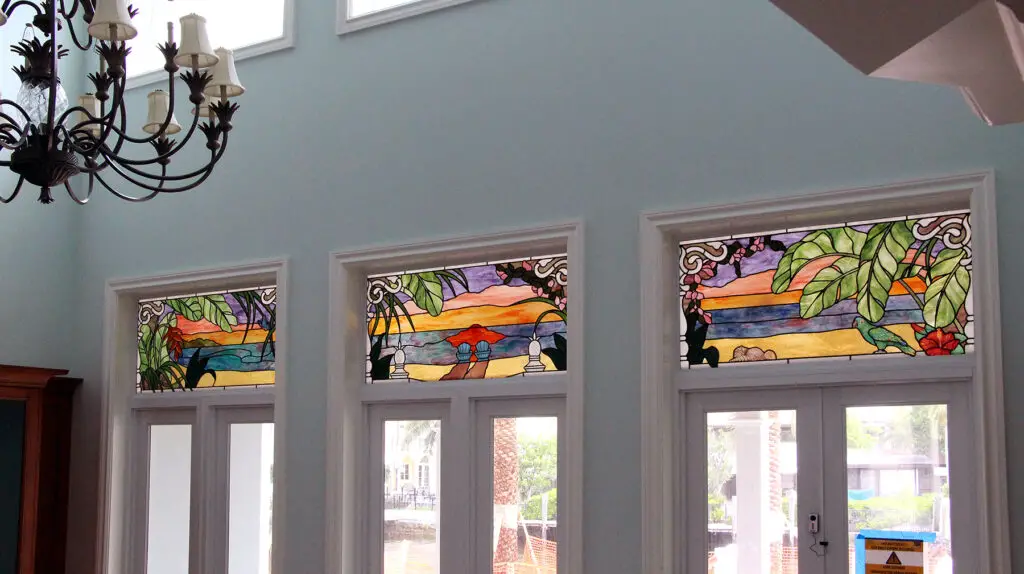
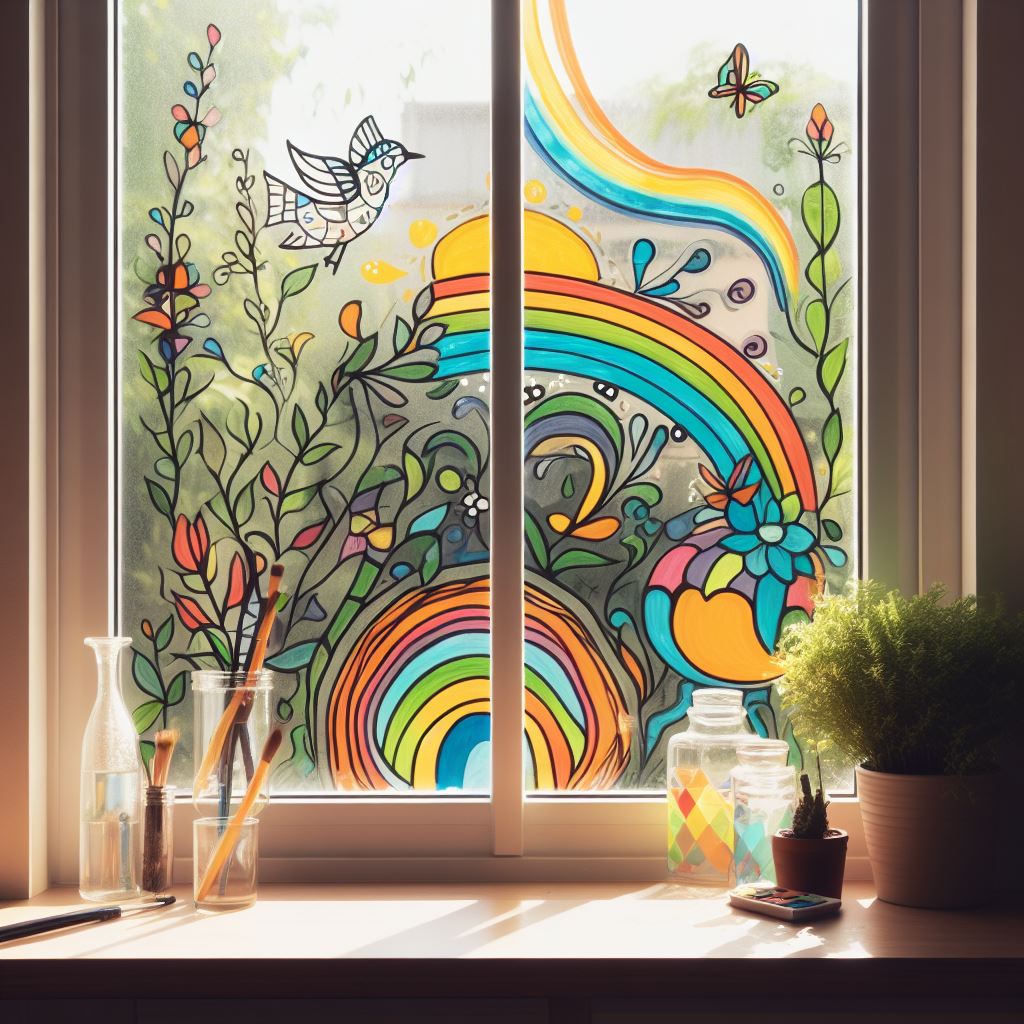
Caring for Your Painted Glass Windows
While your painted glass windows can withstand gentle cleaning, it’s advisable to avoid harsh scrubbing. Simply rinse with warm water to keep them looking their best.
Removing Paint from Glass Windows
We all make mistakes and while some may prefer to embrace them, others might be inclined to fix them. If you make any mistakes that you would like to correct, the best thing to do would be to fix them as soon as you notice them, and ideally before it dries. Any mistakes made with tempera or washable paint can be cleaned up quickly with a paper towel or a wet rag. Acrylic, resin, and solvent-based paint mistakes should be cleaned up immediately with a rag and some paint thinner as they can become permanent after they dry.
Unleashing Further Creativity: Advanced Techniques for Glass Window Painting
In the captivating world of glass window painting, where creativity knows no limits, let’s explore advanced techniques to enhance your artistic journey. While the main guide has laid a strong foundation, this additional content aims to provide detailed insights and broaden your skills.
Exploring Advanced Paints: Beyond the Basics
While acrylic enamel paints are a fantastic starting point, exploring advanced options can add a new dimension to your window art. Consider venturing into UV-resistant paints for longevity against sun exposure. Brands like DecoArt Glass Stains offer a stunning array of translucent colors, perfect for achieving intricate designs with a stained glass effect.
Mixed Media Magic: Incorporating Texture and Depth
To add a tactile quality to your window art, experiment with mixed media techniques. Incorporate texture by adding fine sand to your paint for a gritty finish or mix clear glue with paint for a raised effect. This not only enhances the visual appeal but also provides a sensory dimension to your creations.
The Elegance of Etching: Etched Glass Painting Techniques
For a touch of sophistication, consider etching techniques. Mask off areas with intricate patterns using self-adhesive stencils or create your designs using a liquid etching cream. This technique allows light to play through the etched portions, creating a captivating interplay of light and shadow.
Layered Landscapes: Building Depth in Your Designs
Go beyond basic patterns and explore the art of layering in your window paintings. Capture scenic landscapes or detailed cityscapes by adding layers of paint to create a sense of depth. This technique not only brings intricacy to your designs but also encourages viewers to explore the story within each layer.
Mastering Metallics: Shimmer and Shine
For a touch of opulence, explore the world of metallic paints. Brands like Liquitex Metallic Acrylics offer a rich palette of shimmering hues that can enhance specific elements in your designs. Whether it’s accentuating borders or adding a metallic sheen to focal points, these paints provide a luxurious touch.
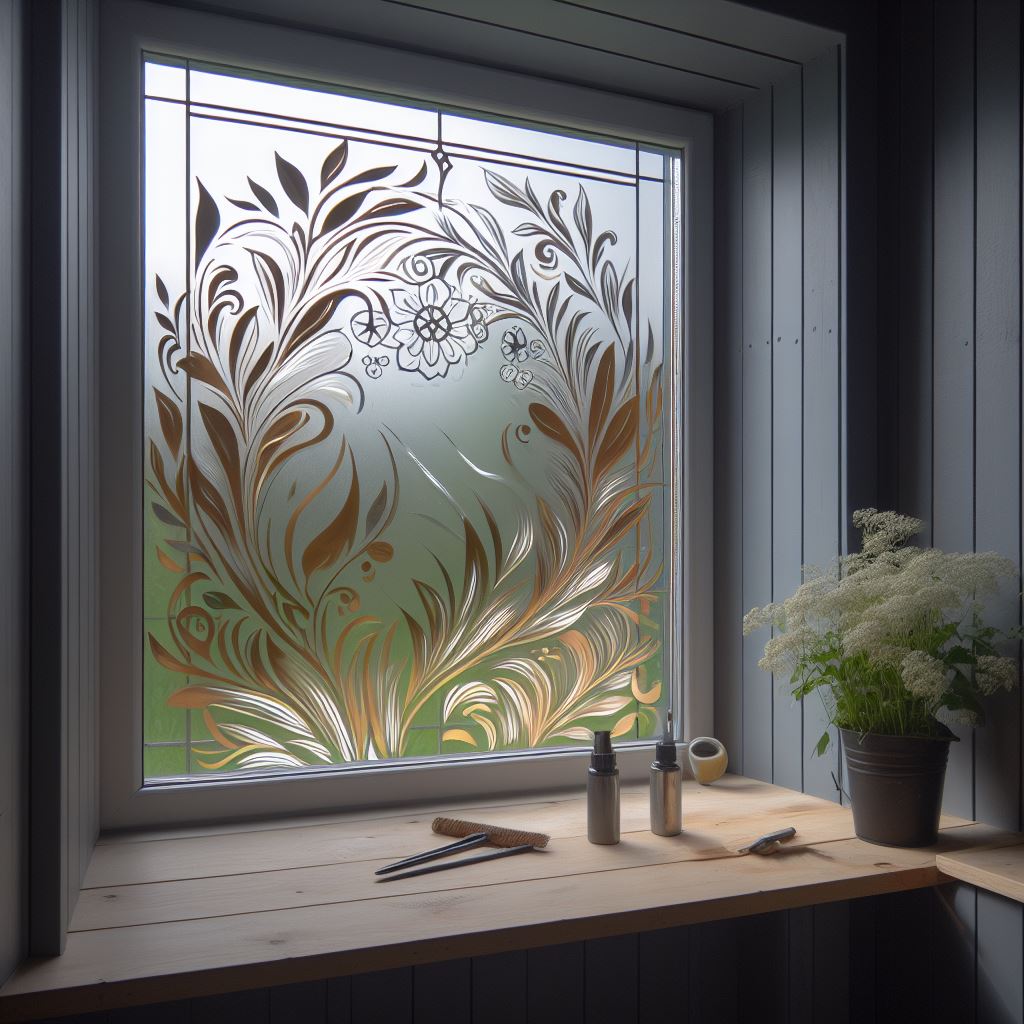
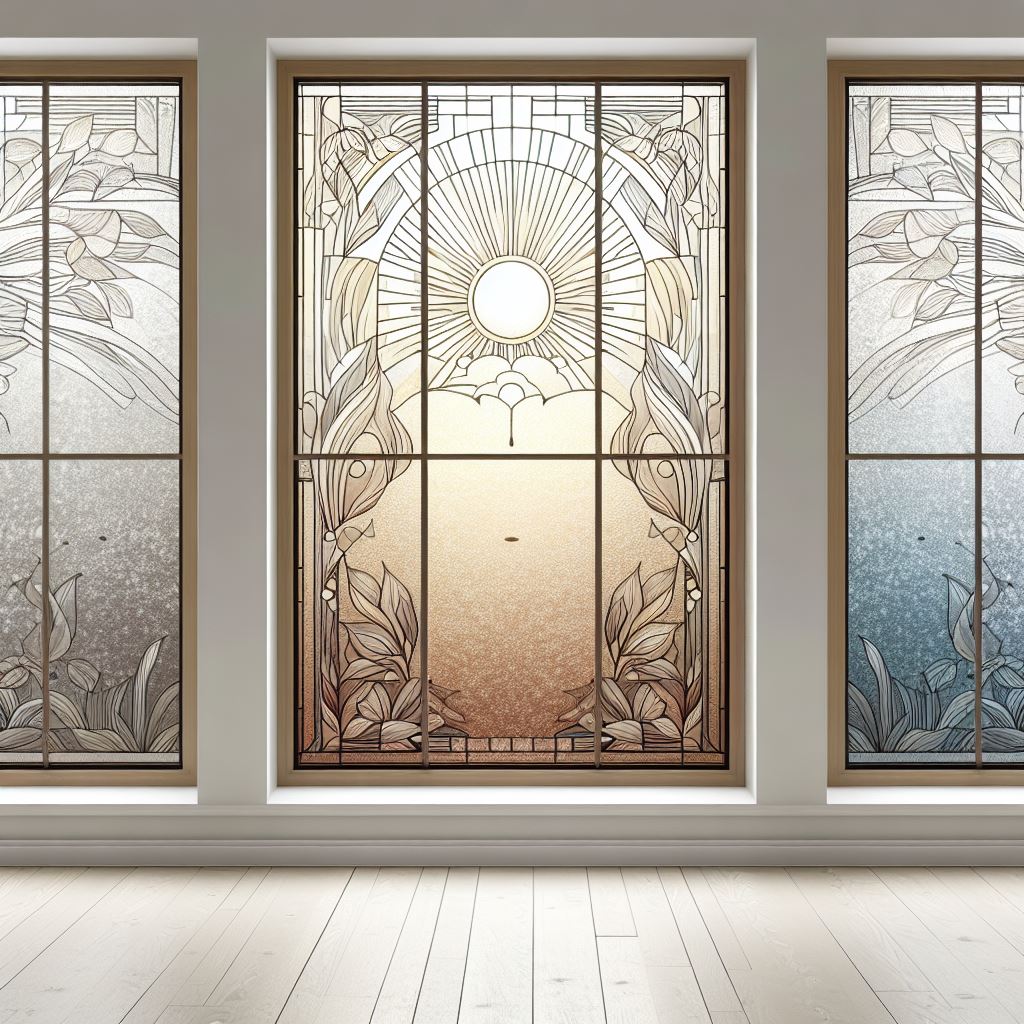
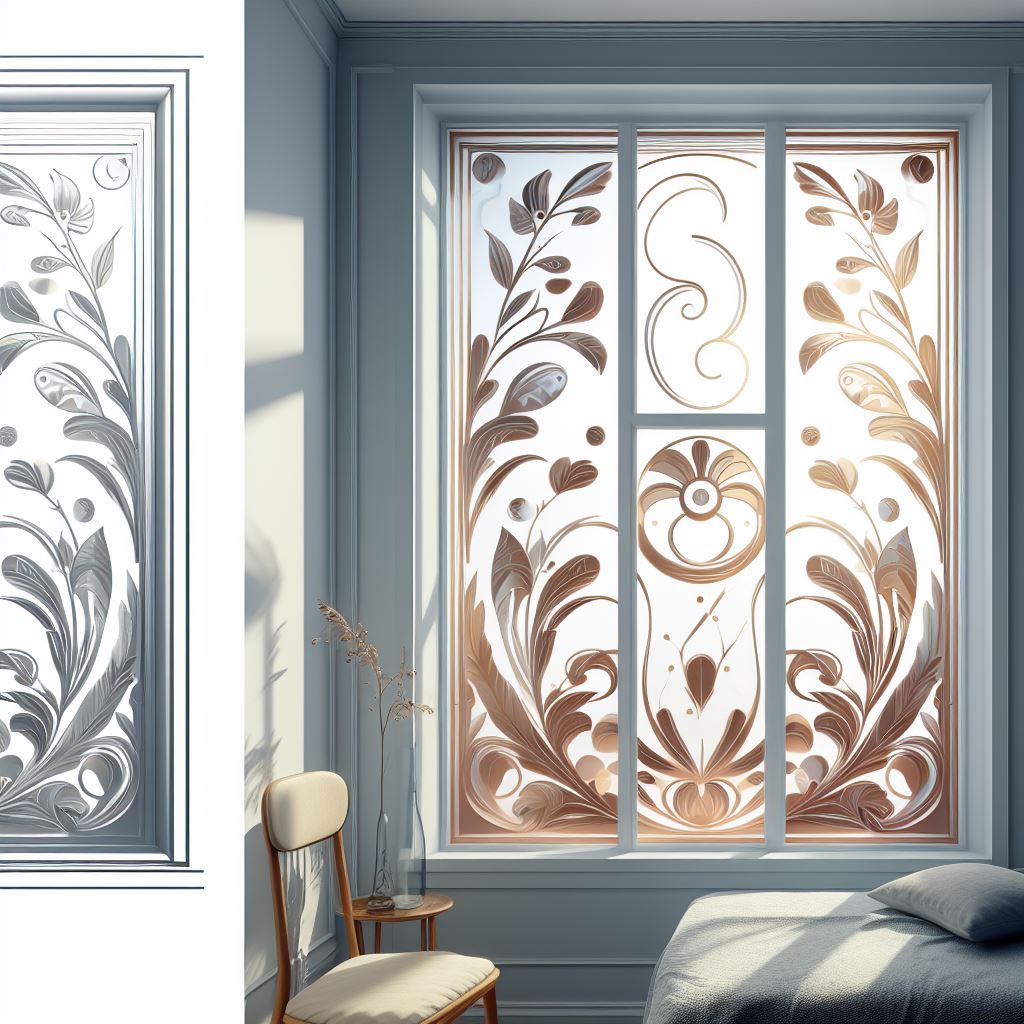
Interactive Art: Glow-in-the-Dark Delights
Infuse an element of enchantment into your glass art by experimenting with glow-in-the-dark paints. Create mystical scenes or highlight specific elements that come alive in the darkness. This technique not only surprises viewers but also transforms your glass art into a dynamic, day-to-night spectacle.
FAQs
Why should I consider glass windows painting?
Glass windows provide a unique canvas for artistic expression, allowing you to personalize your living space and add a touch of creativity. Painting them can enhance privacy, infuse your personality into your home decor, and do so cost-effectively.
What types of paint are suitable for glass windows?
Several paint types work well on glass surfaces. Acrylic enamel paint is a versatile option, delivering various finishes and excellent durability. Additionally, for specific effects, frosted glass paint and acrylic paint with gesso are suitable choices. Lastly, if you’re aiming for temporary designs that can be cleaned off easily, tempera paint is a water-based option to explore.
How do I choose the right brushes for glass windows?
Synthetic bristle brushes are recommended, as they are less likely to leave marks on the glass. You can also use rollers or sponges for larger areas. For beginners, BOSOBO Paint Brushes offer reliable performance, while ARTIFY Paint Brushes provide superior craftsmanship for professional projects.
What materials do I need for painting glass?
To get started with glass window painting, you’ll need paint, brushes or sponges, painter’s tape, a bucket of water for cleaning brushes, protective gloves, paper, scissors, and more. Make sure to gather these materials before you begin your project.
Wrapping Up
Glass window painting is a rewarding and budget-friendly way to transform your living space. With the right supplies, techniques, and a touch of creativity, you can achieve stunning results that reflect your personal style and enhance both privacy and aesthetics. Combine techniques, experiment with colors, and let your creativity flow freely. The world of glass window art is not just about painting; it’s a dynamic exploration of possibilities. Get started today, and let your windows become a canvas for your artistic expression!
Also read our tips: What is the Difference Between Acrylic Paint Vs Satin Acrylic Paint
For more than 15 years, I’ve been immersed in the world of painting, and I’ve created this website to share my passion and knowledge with fellow art enthusiasts. My artistic journey has led me through various mediums, techniques, and styles, always pushing the boundaries of expression. I invite you to explore the captivating realm of art with me – a journey of creativity, self-expression, and the endless possibilities that painting offers.
Feel free to reach out to me via email at leanna.ange@gmail.com. Whether you have questions, want to share your own artistic experiences, or simply connect, I’m here to engage in the wonderful dialogue that art inspires. Looking forward to hearing from you!

